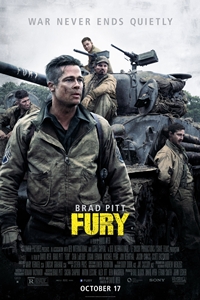 Fury
Fury
Starring Brad Pitt, Logan Lerman, Shia LaBeouf,Michael Peña and Joe Bernthal
Directed by David Ayer
From Columbia Pictures
Rated R
134 minutes
by Michael Clawson of Terminal Volume
Fury plays fast and loose with its military action, but never with its stars — the tanks.
The metal goliaths, featured heavily in David Ayer’s World War II epic, crunch into battle at a tedious pace and with the subtlety of, well, a smoke-belching tank. “Over there,” a soldier says pointing at a treeline, and off the tank goes to blast the bushes into yard mulch. The tanks turn and chug toward danger because that’s what they were designed to do — battering rams, roadblocks and troop shields. It does not make for the most plausible, nor exciting, action sequences. More on that later.
The film follows a tank crew during the final push through Germany before the fall of the Third Reich. It’s April 1945, weeks away from Hitler’s suicide, when the German people, including women and children, were told to defend the country until the very end. The tank, called Fury, is captained by Wardaddy (Brad Pitt), a battle-hardened Nazi-killer with a cool temperament. His crew includes Bible (Shia LaBeouf), Gordo (Michael Peña) and Grady (Joe Bernthal), and they are crudely jaded by war and its atrocities. They make the soldiers from Samuel Fuller’s The Big Red One look like Sunday School teachers.
The film shepherds us into the war with a surrogate, fresh-faced teen Norman Ellison (Logan Lerman), who has been assigned to Fury from a cushy position at headquarters. “I type 60 words a minute. I’m not meant to be here,” he pleads with the tank and its crew. Norman is given a position at the front of the tank, where he operates a machine gun turret next to the driver. When it’s safe to do so he pops his head out of a hatch and gets a nice view as the tank bops down the German countryside. During a firefight, he drops down under the hatch and uses a nifty periscope to (barely) see what, or who, he’s shooting at.
Ayer’s film, which he also wrote, establishes one principle very early on: the tanks, even with their armor plating, are fragile monsters. One wayward bullet and gas ignites, shells explode and the tank turns into a convection oven. Then, of course, there are German bazooka teams, landmines and the nearly impenetrable tiger tank, a feared enemy by any Allied soldier. It’s amazing any of these brave tank crews survived the war. Making things more hazardous is the way the tanks fight in Fury’s battles: when meeting the enemy, tanks turn and grumble into the action in a straight line. While dog-faced infantrymen use cover, weave through the trees and generally try to use a tactical approach, the tanks just drove in, which makes for anti-climactic action sequences. Maybe this is the way the real tank battles were fought, in which case the film nailed it, but I couldn’t help but think of Civil War movies and the frustrating tactics that those soldiers used. Marching into bullets in spiffy rows of targets likely got a lot of men killed.
This tactical curiosity is clearly seen in one sequence where a column of tanks face off against a single tiger tank. The American tanks turn to engage and then chug forward as the German foe obliterates one tank after another. Was there not another way to fight this battle? I will say this, though, the tanks looks amazing. A lot of work went into their creation, and they are convincing creatures unto themselves. Especially noteworthy are the shell effects, with high-velocity tank shells ricocheting off hulls, bouncing off soggy soil and piercing armor in perfectly round holes. The threat of a tank barrel pointed at the screen felt real, with terrifying consequences. The same can’t be said about the regular bullets, which only found American flesh when the plot demanded it. Germans were apparently awful shots or crack shots, but never a mixture of both. The movie doesn't treat all hand grenades equal either: American hand grenades had quick fuses that exploded on contact, yet German grenades were so slow to blow up that Americans could snatch them up and heave them back. Was this a real difference between the two armies, or was Ayer’s script skewed for its heroes?
Forgiving the munitions, Fury is mostly about the main tank and its ultimate destiny at a German crossroads, but the film isn’t shy about turning its attention on the tank’s human controllers, be it Gordo and his Mexican heritage or Grady and his backwoods mumble. One noteworthy performance is by LaBeouf, fresh off his crazy tour, as a Bible-thumping creepo. He initiates one of the more interesting conversations in the movie: if anyone can be “saved” by Jesus’ grace then couldn’t Hitler be saved? He’s truly stumped.
The central characters are Wardaddy and Norman, playing master and apprentice. Pitt’s Southern snarl is lewd and nasty, but he imbues the character with a gritty affection. “Wait til you see it … what a man can do to another man,” Wardaddy, the Davey Crockett to the tank’s rolling Alamo, says to Norman. “Ideals are peaceful. History is violent,” he adds later. These two characters take Fury on a hard left turn as they wander through an apartment complex and meet two German women. Tension fills the room as Wardaddy removes his clothes and makes glances toward a bedroom. But the scene didn’t go where I thought it would, and it instead revealed a great deal about Fury’s heroes. Although the scene is a dramatic detour, one I greatly enjoyed, it does not knock the tracks off the movie’s momentum.
The photography is, at times, exceptional, including several scenes that are worthy of commendation: a formation of bombers weaving a metal carpet in the sky, shots of Americans playing baseball with stack of worthless German money, and a stunning opening shot of a German on horseback riding through the mists of war, the battle-churned mud, and the pierced and smoldering carcasses of beetles with names like Panzer, Tiger, and Sherman. This can be a gorgeously ugly movie.
Fury isn’t the greatest World War II movie, but it is a noteworthy one, despite its sluggish depiction of tank warfare. It proves that there are still many stories worth telling from a 70-year-old war.









